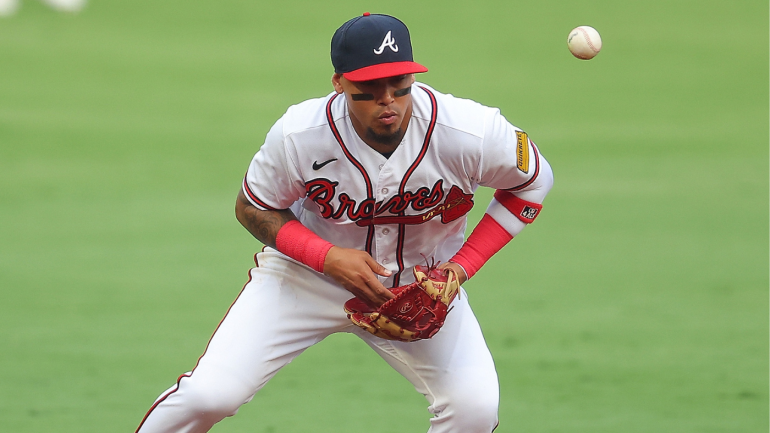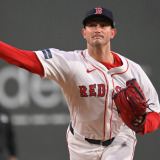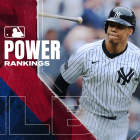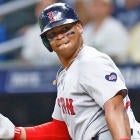
The 2023 MLB trade deadline is in the rearview mirror and we are well into the dog days of August now. Six-and-a-half weeks remain in the regular season and soon the division and postseason races will kick it into high gear. There is still plenty to be decided with less than two months to play.
Our bi-weekly series breaking down various trends across the league continues Wednesday with a look at one young hitter's breakout, a former MVP's bounce-back season, and the league-wide decline in errors. Three weeks ago we examined one way Elly De La Cruz can get better, Baltimore's looming rotation problem, and reasons to think Lance Lynn was a good trade target.
Witt breaking out for KC
A year ago Royals shortstop Bobby Witt Jr., the No. 2 pick in the 2019 draft, became only the fifth rookie in history with 20 home runs and 30 stolen bases (Diamondbacks outfielder Corbin Carroll became the sixth this year). He flashed an exciting power/speed skill set. The only real negative: Witt had a .294 on-base percentage. That's an eyesore and a bad number, even for a rookie.
This beginning of this season was much of the same. Witt was sitting on a .228/.266/.430 batting line on June 1, leading to speculation he could be sent to Triple-A. Since then though, Witt has played like a superstar, hitting .321/.365/.556 with 13 home runs and 17 steals in 63 games since June 1. He recently became the first player ever to begin his career with back-to-back 20-homer, 30-steal seasons.
There were signs Witt was about to break out early in the season. First and foremost, he was crushing the ball. His ball-tracking data (exit velocity, etc.) ranked near the top of the league. He also began to tighten up his plate discipline and overall approach, with fewer chases on pitches out of the zone and more contact on pitches in the zone, rates that have further improved in recent weeks.
Witt's defense has improved too. He began last season at third base before sliding over to shortstop full-time in the middle of May. As a shortstop, he posted minus-4 defensive runs saved and minus-3 outs above average. Those numbers jumped to plus-1 DRS and a staggering plus-14 OAA this season. Witt has credit a better first step for improving is defense.
Development is not linear. Even the most talented players -- all you need to watch is one game to see how naturally gifted Witt is -- can need time to figure this game out. Witt's raw skills allowed him to go 20/30 last season. This year he's refining his game and his approach, and he's taken real steps toward stardom the last three months. The Royals have their new franchise player.
"It should be a lot easier. That transition's kind of taken place," Royals GM J.J. Picollo told the Kansas City Star about Witt in spring training. "He knows he belongs. Now we would expect him to be a little bit more relaxed, not that we didn't feel he was. But just a little more confident in who he is and what he can do."
MVP Yelich returns
OK, MVP is overstating it because the 40-homer power hasn't returned, but Brewers outfielder Christian Yelich has been performing like an MVP candidate the last few months. From 2021-22, Yelich slashed .251/.358/.379 in 271 games, and neither Yelich nor the Brewers could explain why his game had skipped from his MVP peak in 2018 and 2019.
The start of this season was more of the same: Yelich hit .223/.316/.340 in April. But, since the calendar flipped to May, he owns a .309/.394/.499 batting line with 13 home runs in 89 games. That's a notch below Yelich's 2018-19 output, though it is certainly very good overall, and significantly better than his 2021-22 numbers. He had a strong case for his third career All-Star Game selection, but ultimately did not make it.
Yelich's return to glory this season comes down to the ol' No. 1. He's back to hammering fastballs. Check it out. These are Yelich's numbers against fastballs:
| AVG | SLG | HR | Exit Velo | Whiff Rate | |
|---|---|---|---|---|---|
2021-22 | .282 | .404 | 12 | 91.4 mph | 18.9% |
2023 | .336 | .577 | 12 | 93.0 mph | 17.8% |
MLB avg vs. FB | .264 | .466 | -- | 89.9 mph | 20.4% |
Whatever the reason, Yelich lost the ability to slug against fastballs from 2021-22. He made plenty of contact (better than average whiff rate) and hit the ball hard (better than average exit velocity), but the power production wasn't there. It has come back and then some this year. More contact, more power, and a better version of Yelich overall.
I'm inclined to think Yelich's 2021-22 woes were health related. He's had on-and-off back trouble over the years and a foul ball broke his kneecap in Sept. 2019. Yelich and the Brewers insisted he was healthy, though I have a hard time believing a 100% healthy Yelich just stopped being a productive player in the prime of his career. Nagging injuries, or perhaps apprehension following those injuries, may have been the culprit.
Regardless, Yelich is back to being an impact hitter this season and boy do the Brewers need it. Their offense is in the bottom third of the league in runs per game, batting average, on-base percentage, slugging percentage, and a lot more. Also, the Brewers owe Yelich $136.5 million through 2028. A contract like that going sour can cripple a small-market team. Yelich's resurgence has helped the 2023 Brewers tremendously and is also a positive sign for the rest of his contract.
The decline of errors
You needn't be a hardcore fan who watches every inning of every game to notice something unusual about the 2023 season. About official scoring, specifically. Curious is the best word to describe it, I think. Balls that look like clear errors are instead scored hits. It happens game after game, night after night, and has been all season. Here's a recent example:
That batted ball, which had a 77.7 mph exit velocity, did not require extraordinary effort. Braves shortstop Orlando Arcia just whiffed on it. It happens. Even the best players and most gifted defenders make mistakes. And yet, it was scored a hit. Anecdotally, these 50/50 balls are being scored base hits more often than efforts these days, and the numbers back it up. The league error rate has plummeted in recent years:
- 2019: 1.19 errors per game (between the two teams)
- 2020: 1.17
- 2021: 1.08
- 2022: 1.06
- 2023: 1.01
The 2020 pandemic season was bizarre and if you want to ignore that completely, be my guest. Look how much the error rate has fallen since 2019 though. The difference between the 2019 and 2023 error rates is one error every 5.6 games league-wide, so more than two a night. Across a full 162-game season, the difference between the 2019 and 2023 error rates is 437 errors. Turn 437 errors into hits in 2019, and the league batting average jumps two full points from .252 to .254.
Fewer errors also equals fewer unearned runs, though keep in mind not every error leads to a run and sometimes one single error can lead to many runs. It's not as simple as one error equals one hit and vice versa. This season there are 0.67 unearned runs per game league-wide. In 2019, it was 0.74 unearned runs per game. Apply the 2023 unearned run rate to 2019 and the league ERA jumps slightly from 4.49 to 4.51.
The popular social media conspiracy theory is MLB directed official scorers to rule more 50/50 balls hits to inflate the league batting average at a time when MLB enacted rules intended to do exactly that (limits on infield shifts, pitch timer, etc.). An MLB official told The Athletic there has been no such directive, instead noting the pitch timer puts more pressure on everyone and the league has worked to standardize official scoring across the league. They want official scoring to be as uniform as possible.
Also, it should be noted the league error rate has been trending down since the 1970s. There were 1.77 errors per game in 1970. That number gradually dropped to 1.71 in 1980, 1.51 in 1990, 1.42 in 2000, and 1.25 in 2010. Clearly though, that decline has accelerated in recent years, and MLB is on pace to post its lowest error rate in history this season. It's all bookkeeping that has no real impact on the action on the field. It is a rather significant shift in a short period of time though.


























